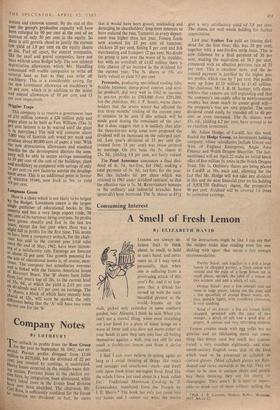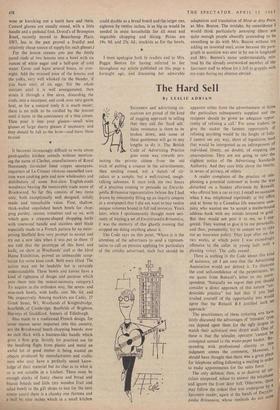Consuming Interest
A Smell of Fresh Lemon
By ELIZABETH DAVID
find I can even believe in eating again so long as I avoid thinking of things like oxtail and sausages and sauerkraut-ouch--and dwell only upon fresh bitter astringent food; food like the salads I have just read about in a book called Fez: Traditional Moroccan Cooking by Z. Guinaudeau, translated from the French by J. E. Harris.* The book has only just come into my hands and 1 cannot say what the results
of the instructions might be like. I can say that the recipes make nice reading even for one shaking with ague; that seems a fair enough recommendation.
Parsley Salad; mix together in a dish a large bunch of chopped parsley, a fresh onion welt minced and the pulp of a large lemon cut in stnall pieces, sprinkle the juice of a lemon on this mixture and add a pinch of salt.
Orange Salad: peel a few Oranges and cut them in large pieces, taking out the pips, add a few spoonfuls of orange flower water, stir, then sprinkle lightly with powdered cinnamon. Is very soothing.
Salad of cos lettuce: a fine cos lettuce, finely chopped, sprinkled with the juice of two oranges, a pinch of salt and a good deal of .pepper. A curious and very refreshing mixture.
Lemon creams made with egg yolks but no gelatine and no thickening come out some- thing like lemon curd but much less concen- trated; a very excellent eighteenth- and nine- teenth-century English sweet dish of the kind which used to be presented in syllabub or custard glasses. (Most syllabub glasses are flute- shaped and curve outwards at the top. They are often to be seen in antique shops and people buy them thinking they are for sherry or champagne. They aren't. It is next to impos- sible to drink out of them without spilling the
*Pub. J. E. Laurent, Oudaia, Rabat, Morocco. 1957. About £2.
wine or knocking out a tooth here and- there. Custard glasses are usually round, with a little handle and a pedestal foot. Drood's of Brompton Road, recently moved to Beauchamp Place, SW3, has in the past proved a fruitful and relatively cheap source of supply for such glasses.)
For the lemon creams you put the thinly pared rinds of two lemons into a bowl with six ounces of white sugar and a half-pint of cold water. Cover and leave several hours, or over- night. Add the strained juice of the lemons and the yolks, very well whisked (in the blender, if you have one), of six eggs. Stir the whole mixture until it is well amalgamated. then strain it through a fine sieve, discarding the rinds, into a saucepan; and cook over very gentle heat, as for a custard (only it is much easier; there is no milk to be curdled by the lemon) until it turns to the consistency of a thin cream. Then pour it into your glasses—small wine glasses or large sherry glasses if necessary, and they should be full to the brim—and leave them to cool.
It becomes increasingly difficult to write about good-quality kitchen utensils without mention- ing the name of Clarbat, manufacturers of Royal Normandy tin-nickel lined copper saucepans, importers of Le Creuset vitreous enamelled cast- iron ware cooking pots and now wholesalers and distributors of some first-class English-made woodware bearing the memorable trade name of Brookwood, So far this consists of two items only, both exceptionally well designed, solidly made and remarkable value. First, shallow, thick-walled unpolished beech bowls for chop- ping parsley, onions, tomatoes and so on, with which goes a crescent-shaped chopping knife with rosewood handle and stainless steel blade especially made to a French pattern by an enter- prising Sheffield firm very prompt to accept and try out a new idea when it was put to them. (I am told that the prototype of this bowl and knife, on show at Woollands' stall at the Ideal Home Exhibition, proved an unbearable temp- tation for some keen cook. Both were lifted. The action may not be laudable but is certainly understandable. These bowls and knives have a kind of rightness of design and purpose which puts them into the instant-necessity category.) To acquire in the orthodox way, the seven- and nine-inch bowls, with knife, cost 30s. 6d. and 34s. respectively. Among stockists are Cadec, 27 Greek Street, WI, Woollands of Knightsbridge, Scurfields of Cambridge. Banfields of Brighton, Harveys of Guildford, Jenners of Edinburgh.
Also made to a traditional French design, for some reason never imported into this country, are the Brookwood beech chopping boards. over an inch thick with a business-like handle which gives a firm grip. Strictly for practical use (in the headlong flight from plastic and metal an awful lot of good timber is being wasted on objects produced by manufacturers and crafts- men who may have a perfectly sound know- ledge of their material but no clue as to what is or is not suitable in a kitchen. There must be enough stocks of fancy cheese and bread and biscuit boards and little tiny wooden fruit and salad bowls in the gift shops to last for the next ninety years) there is a chunky one thirteen and a half by nine inches which in a small kitchen could double as a bread board and the larger one, eighteen by twelve inches, is as big as would be needed in most households for all meat and vegetable chopping and slicing. Prices are I9s. 9d. and 25s. 6d., stockists as for the bowls.
I must apologise both to readers and to Mrs. Peggie Benton for having referred to her throughout my article published on this page a fortnight ago, and discussing her admirable adaptation and translation of Meat at Any Price. as Mrs. Beaton. The mistake, by coincidence I would think particularly annoying (there are quite enough people absurdly pretending to be something to do with Mrs. Beeton without mY adding an invented one), arose because the para- graph in question was sent in by me in longhand and Mrs Benton's name understandably mis- read by the already overworked member of the Spectator staff to whose lot it fell to grapple with my copy during my absence abroad



































 Previous page
Previous page